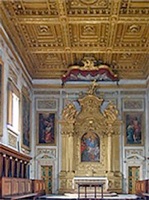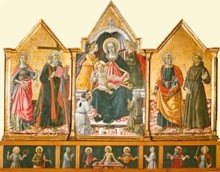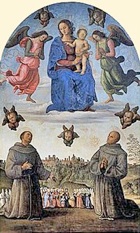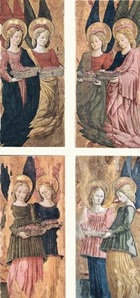


The oratory is reached by the doors in the wall behind the altar of the Oratorio di San Bernardino. It was built on the site of the old Novitiate of San Francesco al Prato as the headquarters of two lay confraternities that merged in 1537:
-
✴The older of the two confraternities was the Confraternita di Sant' Andrea della Giustizia, which had been formed in 1374 to give spiritual support to condemned criminals. The brothers had acquired some property near Porta Santa Susanna, next to the small church of Santa Mustiola, in 1436 and had taken over the church itself in 1454. (A community of Capuchin nuns built the church and nunnery of Santa Chiara on the site of Santa Mustiola in 1552, and the brothers administered their temporal affairs until 1566).
-
✴The second was the Confraternita di San Bernardino, which had been formed in 1456 and had had on oratory at Santa Maria dell’ Oliveto, near Porta Eburnea.
Interior
The box-vaulted ceiling was carved and gilded in 1588.
Most of the paintings that remain in the oratory are from the 18th century.

The inscription on the bak wall records the transfer of the confraternities to this site in 1537.
Madonna and Child with saints (18th century)
This altarpiece on the high altar, which is by Gaetano Lapis, depicts the Madonna and Child with SS John the Baptist, Andrew and Bernardino of Siena.
Art from the Oratory
Triptych of Justice (1475-6)

This triptych from was generally attributed to Fiorenzo di Lorenzo until Michael Bury (see the page on either artist) discovered a document in the archives of the Confraternita di Sant' Andrea della Giustizia that records its commission from Bartolomeo Caporali and Sante di Apollonio del Celandro. The altarpiece was originally in the confraternity's church of Santa Mustiola, and it moved with the brothers to the Oratorio di SS Andrea e Bernardino in 1537. It was given to the Commune before 1872 and entered the Galleria Nazionale in 1895.
-
✴In the central panel, two members of the confraternity kneel before the Madonna and Child, who are flanked by a pair of angels.
-
✴The side panels depict:
-
•SS Mustiola and Andrew; and
-
•SS Peter and Francis.
-
It is significant that St Mustiola holds the Virgin’s wedding ring, because this relic (the Santo Anello), which had long been associated with Santa Mustiola at Chiusi, had been stolen in 1473 and brought to Perugia. (It is now in the Cappella del Santo Anello in the Duomo).
-
✴The predella depicts:
-
•SS Bernardino and John the Baptist, on the left;
-
•the Pietà with the Virgin and St John the Evangelist at the centre, flanked by another two members of the confraternity; and
-
•St Jerome and a soldier saint on the right.
Gonfalon of the Madonna della Giustizia (1496)

The usual name given to the work derives from the fact that it was, for a period, confused with a second banner (now lost) that the Confraternita di Sant’ Andrea (which was also known as the Confraternita della Giustizia) commissioned in 1501.
The banner depicts the Madonna and Child on a cloud with angels, with SS Francis and Bernardino kneeling in a meadow below. St Francis commends to the Virgin a group that includes the priors and their families as well as members of the confraternity. The road behind them leads to Porta Eburnea and the buildings of Colle Landone that were subsequently demolished.
Angels offering roses (ca. 1464)

-
✴One pair came from the Oratorio di SS Andrea e Bernardino in 1863.
-
✴Cappella del Gonfalone, San Francesco al Prato in 1909, the year in which the chapel was closed.
Modern scholarship has determined that the panels were originally arranged in pairs, one above the other, and that they probably decorated two sides of a tabernacle. All of the angels would have looked inwards towards whatever was housed in the tabernacle.
The presence of two of the panels in the Cappella del Gonfalone suggests that the tabernacle might have housed the Gonfalon di San Francesco al Prato (1464), which is also attributed to Benedetto Bonfigli. This banner, for which the chapel was built, is now in the Oratorio di San Bernardino.

